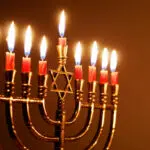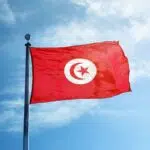A central pillar of the Jewish faith, the Torah is the holy book that details the origins of the Jewish people, the tenets of their faith, and the early history of the religion and its prophets. On Simchat Torah, falling on October 15 this year, Jewish communities celebrate the gift of the Torah and its role in religious life with joyful acknowledgement and meaningful rituals. During this time, rabbis ceremoniously remove the Torah scrolls from their ark, carry them through the congregation, and read specific passages to close out the old cycle and welcome the new.
History of Simchat Torah
Originating sometime in the Medieval period, Simchat Torah celebrates the conclusion of one and beginning of another cycle of Torah reading. The holiday lasts one to two days, with some more Orthodox communities observing it on the day following Shemini Atzeret.
Unlike other Jewish holidays, Simchat Torah doesn’t appear in biblical texts. After the Prophet Moses established weekly scripture readings on Shabbat mornings and festivals, and the Prophet Ezra adding readings on Mondays, Thursdays, and Shabbat afternoons, an order was eventually established.
Babylonian Jews divided the Torah into 54 sections to be read over a year. Later, 12th century European Jews began adding the Genesis reading to the Simchat Torah ritual to assert the belief that every ending leads to a new beginning. During the 20th century, the Simchat Torah gained new significance as a public assertion of Jewish identity, using the joyful and celebratory public dancing around the Torah to affirm and take pride in the Jewish religion and culture.
By Jewish custom, a new beginning must immediately follow an ending. During the Torah reading at Simchat Torah, the beginning of Genesis is read right after the end of Deuteronomy, closing and renewing the cycle.
In contrast with other Jewish holy days that center on the family in the home, Simchat Torah activities focus on the synagogue and the community. The holiday honors the importance of the Torah, Judaism’s holy book, celebrating with joyful dances and rituals that center the book as a pillar of the community. During the evening service, the rabbi brings the Torah through the congregation, who engages in a dance symbolizing their gratitude for the gift of the gospel.
Simchat Torah timeline
Moses leads the Jewish people out of Egypt in one of history’s most epic journeys, wandering the desert for forty years.
As Christianity becomes dominant in Europe, Roman Emperor Constantine outlaws conversion to Judaism and restricts Jewish religious services.
The first Torah scroll is scribed by Yemenite Jews.
After the United Nations approves the formation of a Jewish state, the State of Israel declares itself as an independent nation on May 14, 1948.
Simchat Torah FAQs
How do you celebrate Simchat Torah?
Simchat Torah is celebrated in the synagogue with specific rituals and readings from the Torah in the evening and morning. For many congregations, this is the only time the Torah is removed from the ark and read at night.
Do you work on Simchat Torah?
Observant Jews do not work or travel on this yom tov or “holy day.” Shemini Atzeret is immediately followed by the joyous holiday of Simchat Torah—or “rejoicing of the Law”—which is traditionally celebrated by dancing with Torah scrolls and singing hakafot, songs of praise and gratitude.
What is Shemini Atzeret Simchat Torah?
In the Diaspora, the celebration of Simchat Torah is deferred to the second day of the holiday. Commonly, only the first day is referred to as Shemini Atzeret, while the second is called Simchat Torah. Karaite Jews and Samaritans also observe Shemini Atzeret, as they do all Biblical holidays.
How to Celebrate Simchat Torah
Go to a celebration at your synagogue
Attend Simchat Torah services at your local synagogue to honor and celebrate the gift of this important holy book.
Educate yourself about Jewish culture
If you don’t know much about the Torah, look up the fascinating history of this ancient and storied holy book.
Try some traditional Jewish foods
Jewish culture is known for a variety of delicious and interesting dishes. Find the best Jewish deli in your area and try some new foods.
5 Interesting Facts About Simchat Torah
Materials matter
Torahs are written on parchment made for the skin of a kosher animal using a pen made from a kosher feather with specific black ink.
Torah means "instruction" in Hebrew
The word Torah means teaching or instruction, signifying the important teachings contained in the scripture.
No mass production
Torahs are hand-written and take around a year to write, the same as in the time of Moses.
No mistakes allowed
Over 4,000 laws and regulations govern the writing of a Torah. Even the smallest mistake in penmanship or grammar can mandate the writer to burn the scroll and start over.
Heavy lifting
Each Torah weighs around 25 pounds. If you're tasked with lifting one, get detailed instructions! If it is dropped, everyone in attendance must fast for 40 days to atone for the sin.
Why Simchat Torah Is Important
Every ending leads to a beginning.
Simchat Torah reminds us that the ending of every cycle leads to the beginning of something new.
It's a physical reminder of the Torah's importance.
Simchat Torah is a time when, though normally locked away, the Torah is brought out for everyone to interact with in a gesture symbolizing their gratitude for the gift of the word of God.
It's a modern holiday.
As the only holiday not mentioned in the Scriptures themselves, Simchat Torah is a uniquely modern holiday that celebrates the joy and gratitude experienced from ritually reading the Torah throughout the year.
Simchat Torah dates
| Year | Date | Day |
|---|---|---|
| 2024 | October 25 | Friday |
| 2025 | October 15 | Wednesday |
| 2026 | October 3 | Saturday |






























